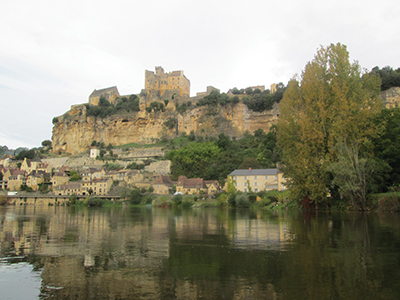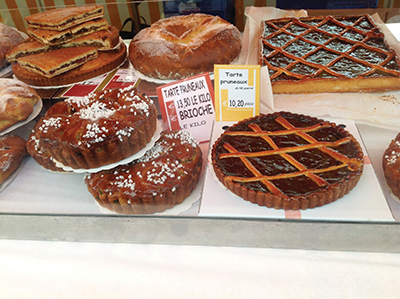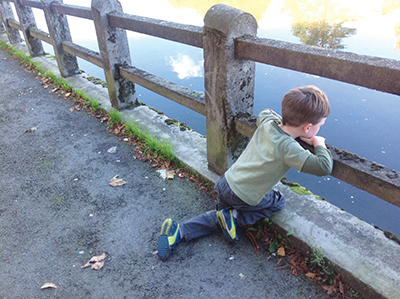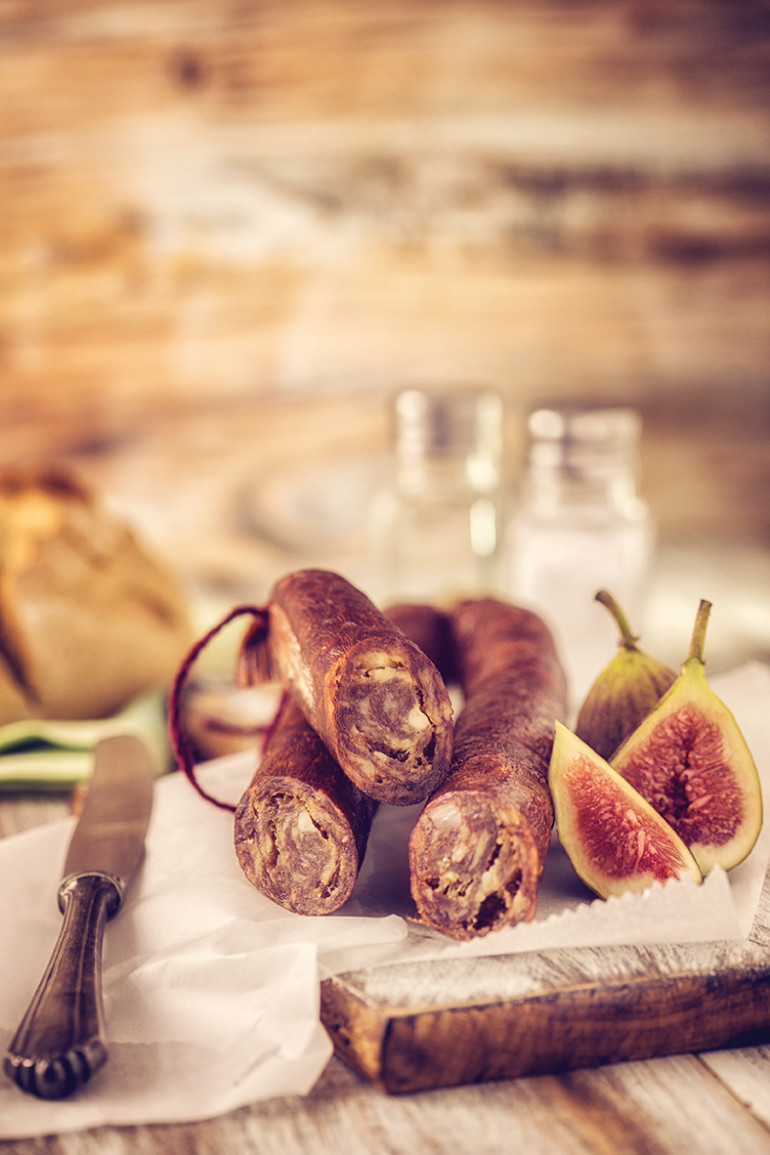
Chateau de Beynac as seen from the Dordogne River.
“Try this. It’s a figue.”
THE 60-SOMETHING MAN, dressed in khaki shorts and a wide-brimmed hat, pulled the purple bulb neatly apart and handed me half. “The fruit still has the freshness of last night’s chill,” he said, smiling. Indeed, despite the sunshine warming my shoulders, the fig’s seedy pulp was cool as Jell-O in my mouth, with just a hint of sweetness.
The man and his wife told us they were visiting from Catalonia, the border region to our south where French and Spanish cultures merge. They were in the Dordogne River valley to see the sights just like us, but while we were in a hurry to climb the steep village path and get a look at our first medieval castle, they were blocking our way, taking their time to select the ripest figs.
“See? This one is no good,” he said, showing us a fig whose pulp was whitish instead of pink orange.
My husband and I decided that touring the Château de Castelnaud could wait a few minutes. These figs were the best thing we’d eaten since arriving in the tiny French town in the southwestern village of Vezac the day before.
On the plane, our Parisienne seat mate nodded in approval as she traced her finger over our planned route from the Dordogne River valley in the Périgord Noir to a farmette in the Midi-Pyrénées.
“You will eat well,” she told us.
That was part of our goal for this trip trip, a 40th birthday present I gave myself. After 10 years of rarely traveling without our three children, my husband and I hoped to luxuriate in the grown-up pleasures of restaurant meals and extra glasses of wine. We wanted to learn about the culture of this region far from the bustle of Paris, where both food and life moved at the leisurely pace of the Dordogne River. We ended up understanding that farm-to-table isn’t a trend here; it’s a way of life — and not just for adults.
We knew our road trip would take us through a region of duck and goose farms, cheese production and a viticulture established long before the vineyards of Bordeaux. But on the first evening of our trip, we ate at a restaurant where the menu boasted mai tais and piña coladas. Surely this wasn’t right.
After touring the castle, we walked down to a canoe outfitter and found it closed for a two-hour lunch break. So instead of paddling past castles and villages on the Dordogne, we wandered the cobblestone paths of La Roque-Gageac, a cliffside village designated as one of the “most beautiful villages of France,” and listened to the sounds of forks and knives clinking on plates inside homes and restaurants. What was it, I asked my husband, that made the local people so entranced with lunch that they needed two full hours to eat?
Like many bed-and-breakfasts in the region, the house where we stayed was owned by an Englishwoman. The next morning, over croissants our hostess Anne had fetched from the local bakery while we slept in, she suggested we seek culinary answers at the weekly outdoor market in nearby Sarlat.
Market Fresh
It took us only 20 minutes to drive our rental car to Sarlat-la-Canéda, a 14th-century village that is on France’s tentative nomination list for UNESCO World Heritage sites, thanks to the loving restoration by author and de Gaulle cabinet member André Malraux in the 1960s. We wandered through a crowd of shoppers toting straw market baskets, welcomed by the smell of freshly baked baguettes, strong cheeses and peppery carrot greens. We approached a cheese case filled with rounds the size of pocket watches and others as big as hubcaps. My husband pointed to a small dark circle and asked to try it.
“That one is too strong for you,” laughed the proprietress — a large-bosomed woman wearing a white apron, a small plastic cup of wine in hand at 10 a.m. — who instead handed us each a slice from a cream-colored round labeled Rocamadour. It was a tangy and smooth goat’s cheese, and we eagerly handed over a few coins for a round. The dark ones, she said, were the same variety, but aged longer.
wine in hand at 10 a.m. — who instead handed us each a slice from a cream-colored round labeled Rocamadour. It was a tangy and smooth goat’s cheese, and we eagerly handed over a few coins for a round. The dark ones, she said, were the same variety, but aged longer.
We considered arguing that we could handle a pungent cheese, but lost our nerve and moved on to the duck vendors.
These were the grandest displays, with foie gras — both fresh and canned — thin slices of smoked duck breast, duck confit, duck gizzards and many parts and preparations we couldn’t begin to identify. We spotted the familiar shape of purple figs and bought some. They were stuffed with foie gras. Once my teeth broke through the chewy fruit, the filling burst into my mouth like meat whipped cream. I was beginning to understand why this was not a place where one rushes through lunch.
Looking for a lunch treat for my husband, we stopped at a display of long saucissons secs, dried sausages. I translated their labels as best I could for my husband, but I got stuck on the word cèpes.
The vendor leaned forward and said, in English, “Cèpes are a kind of mushroom.”
We left the market fortified not only with our stuffed figs, dry sausage, cheese and a loaf of dense brown bread, but also with the sense that the locals were happy to share the secrets of their earthy cuisine, if only we put down our guidebooks and listened. No matter how many customers jostled at the market tables, no vendor had allowed himself to be rushed as he answered our questions and proffered samples. This was not a slow food movement; for the people who laid their tables from this market, slow food was the only food.
Lessons From Milo
During the rest of the trip we passed up museum tours for market days any chance we got. Our food lessons weren’t limited to markets: Outside Lascaux II, the impressive replica of the closed-to-the-public Neolithic painted cave, we noticed French visitors picking things up off the path and stashing them in plastic grocery bags.

Milo at the Villefranche riverfront.
“What are those?” I asked, and learned that people were gathering chestnuts to take home and roast.
Later we got to taste that treat ourselves. We arrived at our trip’s main destination, an ancient limestone farmhouse where an American friend had settled with her French husband, their two small sons, and the boys’ grand-mère and grand-père. After dinner, Grand-mère brought out a warm, fragrant paper bag of chestnuts and showed us how to peel.
“Milo collected these outside his school,” she told us, nodding with pride at her 5-year-old grandson, who was born in San Jose but was quickly putting down roots here on his grandparents’ property outside Villefranche-de-Rouergue, in the Aveyron department.
“He comes home with so many chestnuts in his pockets, his pants are hanging low,” Milo’s mother said with a laugh. As I peeled and tasted the chewy nuts, I wondered what I would say if my own children picked up things off the ground to eat. Probably, “Don’t touch!” Would my kids be willing to try the nuts that Milo was popping into his mouth? Despite living just a few miles from Alice Waters and her efforts to teach children where their food comes from, we were not giving our kids anything like the food education that Milo was getting through everyday life in the French countryside.
Our hosts had asked us to bring a fresh fattened duck liver from one of the Périgord Noir’s farm shops. Now it sat in the refrigerator in the old farmhouse’s modern kitchen, while Grand-mère and Grand-père debated how best to prepare it.
The fate of the foie gras entier had not been settled when we all drove into the village to dine at l’Univers, a hotel restaurant run by Quentin Bourdy. Bourdy was one of the most popular contestants on the 2013 season of Top Chef France, but was eliminated halfway through the competition. Now he had returned to Villefranche to renovate and run his family restaurant.
After an unforgettable meal of mussels in butter sauce and duck breast edged with sumptuous fat, we saw France’s would-be top chef pass the table. Grand-mère seized her chance.
“What is the best way to prepare a foie gras entier?” she asked, pen poised to transcribe his instructions.
That night, we ate the slowly roasted foie gras with sauteed apples from our hosts’ orchard, and Grand-père pulled a special bottle of red Gaillac wine out of his cave on the farmhouse’s ground floor. We finished with tiny glasses of eau de vie, distilled from the property’s plums, toasting the last night of our visit and the success of the famous chef’s recipe. It cheered me to think that it wasn’t just us Americans who were still learning how to enjoy food. After living in France all her life, our hostess was still learning too.
Five-year-old Milo would not let us leave without giving us a tour of the property. In the morning, we opened the farmhouse’s double wooden doors and followed him down the broad stone steps. Milo showed us a heavy cluster of grapes, but then held up his hand.
“Those aren’t ripe,” he warned. “I’ll show you where the ripe ones are.”
Milo’s 2-year-old brother Liam hurried behind us, rain boots protecting his pajama-clad legs from the dewy grass. We passed through the perfume of the flower garden, then the dank barn cellar, to the main garden, where Milo plucked and distributed fat grapes that stained the boys’ faces purple. They spat out the seeds and grabbed more, while my husband and I admired the garden and looked out over the rolling fields of neighbors’ farms, dotted by grazing cows. We could hear the family’s chickens clucking softly as they picked through the grass nearby.
Milo led us to the bee box and asked us to lift some heavy stones off the top so he could open the lid and show us the furry undulating sheet of bees.
Then I spotted something I didn’t need Milo’s help to identify.
“Oh, a figuier!” I said, pointing to a squat fig tree.
Milo grabbed a leathery bulb and pulled off one end, squirting the pulp into his mouth. I did the same, savoring the coolness from the night air preserved in the fruit.


